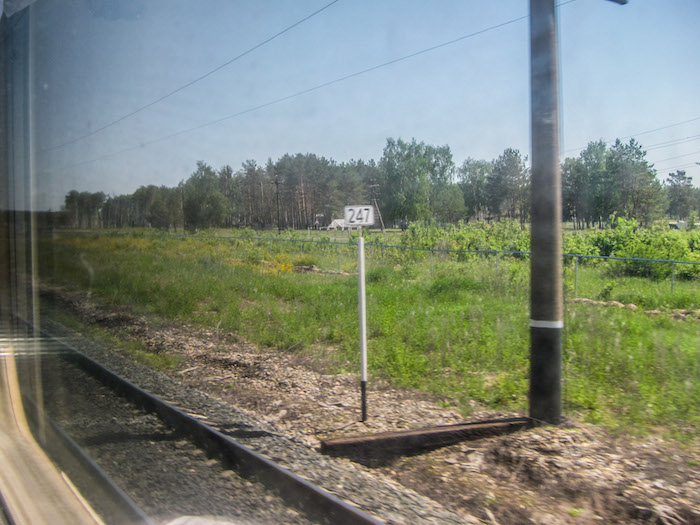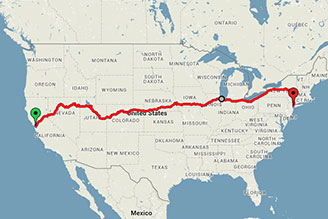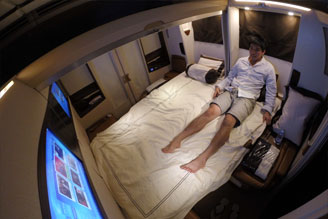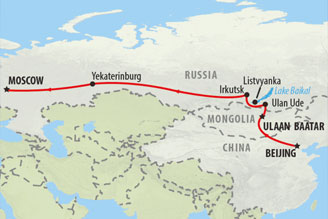My journey across Russia on the Trans-Siberian Railway.

In the late 19th century, some guy thought it would be a good idea to build a train service from Europe across the whole of Asia. This guy was Tsar Nicholas II of Russia. And this project became the Trans-Siberian Railway.
Some 120 years later, it’s still the longest railway line in the world, spanning 9,300 kilometers, 87 cities, 8 times zones and 2 continents. If you take a nap starting at the Gulf of Finland and miss your stop, there’s a chance you’ll wake up at the Sea of Japan.
Considered one of the greatest train journeys in the world, the Trans-Siberian brings passengers into the heart of Mother Russia and its most remote regions. From the comforts of your carriage, you’ll speed pass almost every landscape on Earth, from mountains and snow, to deserts and sandstorms, to forests and lakes.



In May 2011, I backpacked from Asia to Europe alone.
This is my journey on the Trans-Siberian Railway.
Follow me
Keep up with my latest adventures
I arrived at Beijing Railway Station.

I boarded train 3, a direct train heading to Moscow for 6 days.

The train takes a branch of the Tran-Siberian Railway called the Trans-Mongolian.

It starts from China and crosses into Mongolia, before joining the main line through Siberia.

With a lack of common sense you can make the 8000-km journey without getting off, but I decided to make occasional stops along the way.
Beijing to Ulaanbaatar

It’s a 30-hour journey to Ulaanbaatar, the capital of Mongolia.
You choose from three classes of cabin — spalny vagon (first class), kupe (second class), or platskartny (third class).

I had a 4-bed hard sleeper compartment in second class, which I shared with a Hong Konger and a German.

There are no showers onboard the train. And the guy from Hong Kong was heading non-stop to Moscow for six days.

It’s an extremely social journey, and by the first three hours you’re pretty much familiar with your compartment mates and neighbors.
Four-year-old Elena terrorized our carriage.

She spoke terrible English and I spoke terrible Chinese; we got along well. She turned out to be Russian.
There was a Chinese restaurant car.

Nobody enjoyed the complimentary lunch.

Slowly, we made our way north through China's mountainous terrain.

Eventually, the landscape flattens out.

And the engine is swapped for a lower powered one.

13 hours later, we arrived at Erlian, on the Chinese-Mongolian border.

Apparently, the wheels used for the Chinese tracks aren’t compatible with the narrower Mongolian and Russian tracks.
To enter Mongolia, the train had to make a stop to change its undercarriage bogies.

The entire train is lifted up by some amazing hydraulics while you're stuck on the stationary train for three hours. Toilets are all locked so you don’t piss on the engineers working below you.
The next morning, we woke up in Mongolia.

The Chinese restaurant car was replaced with a Mongolian one.

Piece of shit breakfast for 10 USD.

We were now in the Gobi desert.

Even with the windows shut, the sand find its way in.

After miles and miles of desolate land, a sprawling city appears out of nowhere, turning an endless desert landscape to an urbanized field of concrete blocks.
The train finally pulls into Ulaanbaatar.

Mongolia turned out to be such a fantastic destination, I ended up spending a full week there.

Ulaanbaatar to Ulan-Ude

Another 25 hours to Ulan-Ude in Russia.
I took the train to Ulan-Ude just to avoid breaking the journey by train. The train is much slower and more expensive than the bus. An Italian traveler I met at the hostel leaves the following morning by bus and will arrive earlier than me.
To know where you are, there are distance markers at every kilometer, displaying the distance from Moscow or Beijing.

So I spent the next eternity watching these distance markers go pass.

The train finally arrived at the Russian border.
If you thought the immigration lines at airports were bad — we spent 8 hours clearing immigration on the train.
I arrived at Ulan-Ude the following evening.
The only reason to stop at Ulan-Ude is to gaze upon the world’s largest Lenin head. And boy, it was huge.

Ulan-Ude to Irkutsk

A relatively short 8 hours to Irkutsk.
Between Ulan-Ude and Irkutsk lies 20% of the world's supply of fresh water, all contained within Lake Baikal. It's the deepest, clearest, and oldest lake in the world. In fact, it's so old that the species living in the lake have evolved separately from the rest of the world. More than 80% of the animals are endemic and can't found anywhere else in the world.
The train follows the circumference of the lake for some of the most amazing scenery of the whole journey.

I spent several days exploring an island in the lake — Olkhon Island. It turns out to be bigger than my home country, Singapore.

Irkutsk to Yekaterinburg

The longest leg: a 62-hour train ride covering some 3,400 km.
Unaware of the length of the journey ahead of me, I don't know what compelled me to come up with such a stupid idea:
I decided to travel in platskartny, the third class open carriage.

Maybe I'll get to meet some Russians and be merry over vodka!
Nope.
The next day, I woke up and looked out of the window to check my location. I realized that something wasn’t quite right. We were way behind schedule, and staying for far too long at the station.
The train continued for another couple of hours, before stopping again for 3 hours in the middle of no-damn-where in Siberia.I slept. I woke to the same scenery. No way, this isn’t right. People were having conversations with the provodnik (carriage attendant) in Russian that I couldn’t decipher. It’s almost a 15-hour delay in the schedule now. Maybe something was going on.
What’s the worst that could happen? I came up with a few scenarios — the most exciting one being a train derailing in an epic scene of big explosions. And when I returned home I would recount my heroic tale of survival and whatnot.
A few hours later, the train got moving again.
Well, no shit, Derek.
A cargo train a few hours ahead derailed, leaving behind a massive scene of destruction.

It was a complete mess — charred carriages, twisted metal and piles of broken wood.

It was now my third day onboard the train. Owing to the delay from derailment, my food supplies dwindled and I was forced to ration my snacks.You know, at least it wasn't my train.
Only hot water was provided onboard the train.

Everyone came well-prepared for the 3-day train journey with a complete set of utensils, cups and plates. But not me.
To the astonishment of the Russians, I converted my instant noodles cup into a tea cup.

Feeling sober already? Vodka resupply at every major station.


There’s also a strange thing about the time zones.
The length of this journey would take me through 4 time zones overland. All the trains run on Moscow time, but Russia has seven time zones all in all.
Michael Myers Shoemaker wrote in 1902:
“There is an odd state of affairs as regards time over here. Though Irkutsk is 3400 miles from St. Petersburg, the trains all run on the time of the latter city, therefore arriving in Irkutsk at 5 P.M., when the sun would make it after 9 P.M. The confusion en route is amusing; one never knows when to go to bed or when to eat. In an endeavour to follow my instinct yesterday I arrived in the dining car before the fires were lit, and promptly went back to bed. Today I should make it now about 8.30 — these clocks say 10.30, and some of these people are eating their luncheon.”
The clocks all show different times. People who boarded the train at Irkutsk, like me, had our watches adjusted to Irkutsk time (GMT +9). The train stations uses Moscow time (GMT +4), as should the train itself, but our carriage was a full hour slower (GMT +3) possibly due to the failure of correcting for Daylight Savings Time. The provodniks, the carriage attendants, had their watches set to their destinations’ time, usually a major city like Yekaterinburg (GMT +6) or Novosibirsk (GMT +7). And we were delayed by 15 hours from the original train schedule displayed in every carriage.
The train clock shows 03:00 while people are either preparing their breakfast or trying to sleep. Asking the provodniks for the time of arrival at a town creates only more confusion. Am I arriving at 7 or 8 in the morning or evening? Local time or Moscow time? By the next day, it’s impossible to tell if the meal you’re having is lunch or dinner.
Yekaterinburg to Vladimir

A 25-hour journey to Vladimir.
At some point, the train crosses continents from Asia into Europe, marked by a white obelisk.

I stopped in Vladimir to visit the fairy-tale town of Suzdal.
Imagine cramming more than thirty 600-year-old churches into an area less than 9 square km. That's Suzdal.

Vladimir to Moscow

It took 3 hours to get to Moscow, the capital of Russia.
It looks like a short distance on the map. But when you make a comparison, it's just about as large as some other countries.
Moscow feels like a different country from the rest of Russia altogether. It's grand and breathtaking, and it almost puts Paris to shame.

Moscow to St Petersburg

The last stretch: 8 hours to St Petersburg.
Technically not part of the Trans-Siberian line, but no trip to Russia will be complete without visiting St Petersburg.
If Moscow is where you admire the ambition of the Soviet Union, St Petersburg would be where you take in magnificence of Imperial Russia.

Epilogue

The greatest, most boring journey in the world.
It’s been exactly one month since I left Beijing. I was so damn glad to have made it all the way. Siberia’s no joke for a solo traveler — only 3% of people are able to speak English. You can wander the streets asking for help, and only 1 in 33 people can actually understand you.
By this point, I would’ve spent over 161 hours on trains — about 150 hours of it spent in boredom. I guess you’ve to be the kind of person who knows how to occupy themselves to enjoy this kind of thing. The Russian landscape wasn’t that much to look at — mile after mile after mile of Taiga forest. That said, I would love to do this journey again — the whole thing from Moscow to Vladivostok in winter.
For a country that spans such a staggering amount of area, some particularly interesting observations can be made:
The cars change sides.
In the east, cars are conveniently and cheaply imported from Japan, resulting in Japanese right-hand drive cars mixed with left-hand ones from Europe. As you head west, the proportion of right-hand cars on the roads gradually deceases until it’s completely left-hand drive in Moscow. Somewhere in the middle, it’s a strange mix.
The East transforming into the West.
Traveling from the east to the west, you'll see cities transform. Monasteries turn into churches. Toilets evolve from a mere hole in the ground to having proper seats with flush. The number of Asians you meet decreases until you know that you're in Europe.
It's like teleporting to a different land every time you wake up.
One of the most fascinating aspects of the journey was the ever-changing scenery outside of the window. From the mountainous terrain of China, a short nap later and the view changes to farmlands and villages among flat grasslands. Another nap, and you’ll see the barren, lifeless landscape of Mongolia as the train passes through the Gobi desert. And another nap, the Siberian taiga.
How much did it cost me?
$1175 for one month.
| How much? | For what? |
|---|---|
| $240 | Train from Beijing to Ulaanbaatar |
| $42 | Train from Ulaanbaatar to Ulan-Ude |
| $41 | Train from Ulan-Ude to Irkutsk |
| $88 | Train from Irkutsk to Yekaterinburg |
| $81 | Train from Yekaterinburg to Vladimir |
| $11 | Train from Vladimir to Moscow |
| $30 | Train from Moscow to St Petersburg |
| $56 | Russian visa |
| $17 | Moscow policeman bribe |
| $569 | Food, accommodation, and other expenses | $1175 | Total |
Note that this is the backpacker's cost — I slept on strangers' couches, I ate street food, and did everything as cheaply as I could.
That said, I did it to a reasonable extent. I bought souvenirs, paid for museums, and even watched the Mariinsky ballet. I had one hell of an amazing time, and for the same price, there's no reason why you can't.




